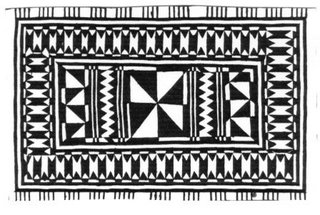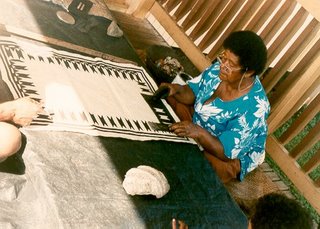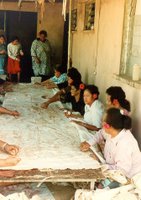The main difference seems to be that Fijian masi kesa is made by stencilling patterns using brown and black natural dyes. Formerly large leaves such as banana leaves had designs cut into them, but more lately stencils are made with clear plastic xray film. In Tonga the designs are made by rubbing over the barkcloth with a relief pattern underneath. In Fijian ceremonies both Fijian and Tongan kinds of barkcloth are used. The Tongan style is called gatu.




Large Tongan cloths are decorated by passing them repeatedly over a table on which various pattern boards have been placed. In this way the designs are copied repeatedly to obtain a decorated cloth of almost any desired length.
The raw material for these decorated cloths is the paper mulberry tree. Small trees are stripped of their bark, the inner part of which is then soaked and pounded out into flat sheets several feet long and a foot or two wide. These are then felted together to make larger sheets, which can in turn be cut to sizes required for various purposes.
The dye is made from soot collected from the burning nut of a candlenut tree, mixed with a solvent such as kerosene.
Browns and blacks dominate the tapa patterns against the near-white of the fibrous masi cloth. Rusty browns are generally made from a mix of the mangrove plant infused with candlenut bark. Other reds are from the iron oxides in the red clays so abundant in parts of Fiji. And the blacks are usually from the charred candlenuts or the burnt tree resin of the dakua tree.

7 comments:
When I lived in a less than secure neighborhood, I used to keep a tapa mallet by the bed. :^O
"Bark" cloth. Woof.
Panda, a tapa mallet? What kind of neighbourhood was that? Surely not Taveuni!
W.
Momo
Miau!
Maui, in a bad part of Wailuku where we had to rent a house for a year. Never needed it, but it made me feel better to have it there.
There is a problem with ICE - cyrstal meth anphedamine - in Hawaii, ruining lives.
from w
I found a website about the making of masi in Fiji. It is http://www.abc.net.au/arts/artok/craft/s193440.htm
Would you believe it my thesis at the RCA was on this very topic. I think I bored the examiner into passing me! And yes, only Fiji developed the use of stencils, though things have changed if they're not using banana leaves any more.
This is a really interesting article. Julie Oakley left a comment about her research was it on Barkcloth from Tonga? Lisa
Post a Comment